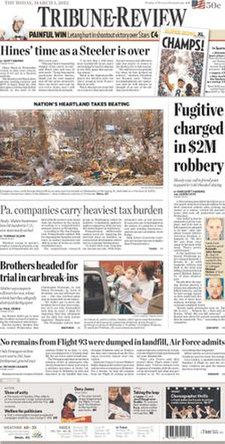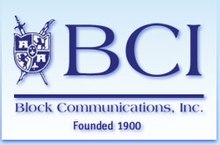The Pittsburgh Post-Gazette, also known simply as the "PG", is the largest daily newspaper serving metropolitan Pittsburgh, Pennsylvania, United States. It has won six Pulitzer Prizes since 1938.
Early history

Gazette
The Post-Gazette began its history as a four-page weekly called The Pittsburgh Gazette, first published on July 29, 1786 with the encouragement of Hugh Henry Brackenridge. It was the first newspaper published west of the Allegheny Mountains. Published by Joseph Hall and John Scull, the paper covered the start of the nation. As one of its first major articles, the Gazette published the newly adopted Constitution of the United States.
In 1820, under publishers Eichbaum and Johnston and editor Morgan Neville, the name changed to Pittsburgh Gazette and Manufacturing and Mercantile Advertiser. David MacLean bought the paper in 1822, and later reverted to the former title.
The Gazette's first daily edition appeared on July 30, 1833, as an afternoon paper.
In 1844, shortly after absorbing the Advocate, the Gazette switched its daily issue time to morning. Its editorial stance at the time was conservative and strongly favoring the Whig party. By the 1850s the Gazette was credited with helping to organize a local chapter of the new Republican Party, and with contributing to the election of Abraham Lincoln. The paper was one of the first to suggest tensions between North and South would erupt in war.
After a consolidation of papers in 1877, the paper was again renamed and was then known as the Commercial Gazette.
In 1900, George T. Oliver acquired the paper, merging it six years later with The Pittsburg Times to form The Gazette Times.
Post
The Pittsburgh Post first appeared on 10 September 1842 as the Daily Morning Post. It had its origin in three pro-Democratic weeklies, the Mercury, Allegheny Democrat, and American Manufacturer, which came together through a pair of mergers in the early 1840s. The three papers had for years engaged in vicious editorial battles with the Gazette.
Like its predecessors, the Post advocated the policies of the Democratic Party. Its political opposition to the Whig and later Republican Gazette was so enduring that an eventual combination of the two rivals would have seemed unlikely.
Block-Hearst deal
The 1920s were a time of consolidation in the long-overcrowded Pittsburgh newspaper market. In 1923, local publishers banded together to acquire and kill off the Dispatch and Leader. Four years later, William Randolph Hearst negotiated with the Olivers to purchase the morning Gazette Times and its evening sister, the Chronicle Telegraph, while Paul Block arranged to buy out the owner of the morning Post and evening Sun. After swapping the Sun in return for Hearst's Gazette Times, Block had both morning papers, which he combined to form the Post-Gazette. Hearst united the evening papers, creating the Sun-Telegraph. Both new papers debuted on August 2, 1927.
Joint operating agreement
In 1960, Pittsburgh had three daily papers: the Post-Gazette in the morning, and the Pittsburgh Press and the Pittsburgh Sun-Telegraph in the evening and on Sunday. The Post-Gazette bought the Sun-Telegraph and moved into the Sun-Telegraph's Grant Street offices.
The Post-Gazette tried to publish a Sunday paper to compete with the Sunday Press but it was not profitable; rising costs in general were challenging the company's bottom line. In November 1961, the Post-Gazette entered into an agreement with the Pittsburgh Press Company to combine their production and advertising sales operations. The Post-Gazette owned and operated its own news and editorial departments, but production and distribution of the paper was handled by the larger Press office. This agreement stayed in place for over 30Â years.
The agreement gave the Post-Gazette a new home in the Press building, a comfortable upgrade from the hated "Sun-Telly barn." Constructed for the Press in 1927 and expanded with a curtain wall in 1962, the building still serves as the Post-Gazette headquarters.
Strike, consolidation, new competition

On May 17, 1992, a strike by workers for the Press shut down publication of the Press; the joint operating agreement meant that the Post-Gazette also ceased to publish. During the strike, the Scripps Howard company sold the Press to the Block family, owners of the Post-Gazette. The Blocks did not resume printing the Press, and when the labor issue was resolved and publishing resumed, the Post-Gazette became the city's major paper, under the full masthead name Pittsburgh Post-Gazette Sun-Telegraph/The Pittsburgh Press.
The Block ownership did not take this opportunity to address labor costs, which had led to sale of the Press. This would come back to haunt them and lead to financial problems (see "Financial Challenges" below).
During the strike, publisher Richard Mellon Scaife expanded his paper, the Greensburg Tribune-Review, based in the county seat of adjoining Westmoreland County, where it had published for years. While maintaining the original paper in its facilities in Greensburg, he expanded it with a new Pittsburgh edition to serve the city and its suburbs. Scaife named this paper the Pittsburgh Tribune-Review. Scaife has invested significant amounts of capital into upgraded facilities, separate offices and newsroom on Pittsburgh's North Side and a state of the art production facility in Marshall Township north of Pittsburgh in Allegheny County. Relations between the Post-Gazette and Tribune-Review are often competitive and frequently hostile, given Scaife's longstanding distaste for what he considered the Blocks' liberalism.
On November 14, 2011, the Post-Gazette revived the Pittsburgh Press as an afternoon online newspaper.
On February 12, 2014 the paper purchased a new distribution facility in suburban Findlay Township, Pennsylvania.
Community presence

The newspaper sponsored a major 23,000 seat outdoor amphitheater in Burgettstown, Pennsylvania, the "Post-Gazette Pavilion", although it is still often referred to as "Star Lake", based on the original name, "Star Lake Amphitheater", and later "Coca-Cola Star Lake Amphitheater" under the former sponsor. They gave up naming rights in 2010. First Niagara Bank, which had entered the Pittsburgh market the year before after acquiring National City branches from Pittsburgh-based PNC Financial Services, took over the naming rights to the facility and is now known as the First Niagara Pavilion.
The newspaper once had ventures in television. In 1957, the Post-Gazette partnered with the H. Kenneth Brennen family, local radio owners, to launch WIIC-TV (now WPXI) as the area's first full-time NBC affiliate. The Post-Gazette and the Brennens sold off the station to current owner Cox Enterprises in 1964. Although the Post-Gazette and WPXI have on occasion had some news partnerships, the Post-Gazette's primary news partner is now KDKA-TV.
Financial challenges

In September 2006, the paper disclosed that it is experiencing financial challenges, largely related to its labor costs. The paper also disclosed it had not been profitable since printing had resumed in 1993. As a result of these issues, the paper is considering a number of options, including putting the paper up for sale. While deep concern about the paper's future ensued, negotiations proved fruitful and in February, 2007 the paper's unions ratified a new agreement with management mandating job cuts, changes in funding health care benefits and so forth.
Awards
The Post-Gazette won Pulitzers in 1938, 1986, 1987 and 1998. Photographer Morris Berman maintained that the paper would have won a Pulitzer in 1964 but chose not to run his iconic Y.A. Tittle picture that he took at Pitt Stadium. The photo would go on to win awards, hang in the Pro Football Hall of Fame, be used for the back cover of Tittle's autobiography and used in a Miller Beer High-Life commercial in 2005.
In 1997 Bill Moushey won the National Press Club’s Freedom of Information Award on a series investigating the Federal Witness Protection Program and was a finalist for the Pulitzer.
The Post-Gazette also was instrumental in Pulitzers in 1992.
Popular Culture

The paper was featured on the August 15, 2013 Colbert Report for its coverage of a Washington County, Pennsylvania fracking lawsuit.
Prices
Post-Gazette per copy prices are: daily, $1 & Sunday/Thanksgiving Day, $2 throughout Pennsylvania, including Allegheny/adjacent counties.
See also
- Chronicle-Telegraph Cup
- Pittsburgh Tribune-Review
- Tom Barnes
- Cy Hungerford
- James O'Toole
- Martha Rial 1998 Pulitzer Prize Winner
- Dennis Roddy
- Bob Smizik
- Y.A. Tittle Photo
References
Bibliography and further reading
- Andrews, J. Cutler (1936). Pittsburgh's Post-Gazette: The First Newspaper West of the Alleghenies. Boston: Chapman & Grimes.Â
- Thomas, Clarke M. (2005). Front-Page Pittsburgh: Two Hundred Years of the Post-Gazette. Pittsburgh: University of Pittsburgh Press. ISBNÂ 0-8229-4248-8.Â
- "Daily and Sunday Newspaper Circulation". Newspapers First. 2006-03-31. Retrieved 2007-03-01.Â
- "2007 Top 100 Daily Newspapers in the U.S. by Circulation" (PDF). BurrellesLuce. 2007-03-31. Retrieved 2007-05-28.Â
External links
- Official website
- History of the Post-Gazette
- Google News Archive microfilm archive 1927-2007
- Post-Gazette.com Mobile
- C-SPAN piece on the Post-Gazette
